Consumer Satisfaction and Waitrose: A Comprehensive Report
VerifiedAdded on 2020/06/03
|23
|5537
|87
Report
AI Summary
This report delves into an analysis of consumer satisfaction within the context of Waitrose, a prominent UK supermarket chain. The research aims to identify factors influencing consumer purchasing decisions, market trends, and preferences, ultimately seeking to develop strategies for enhancing consumer satisfaction. The methodology employed includes both secondary and primary research, with a focus on quantitative data collection via questionnaires administered to a sample of 125 respondents. The findings are analyzed using statistical methods, including ANOVA and t-tests, to assess the impact of factors like age and employment on satisfaction levels. The report encompasses an executive summary, introduction, literature review, methodology, findings, discussion, recommendations, and conclusion, offering a comprehensive overview of the research process and outcomes. Ethical considerations and research limitations are also addressed, providing a balanced and thorough investigation into the topic.

CUSTOMER
SATISFACTION ON
WAITROSE
SATISFACTION ON
WAITROSE
Paraphrase This Document
Need a fresh take? Get an instant paraphrase of this document with our AI Paraphraser
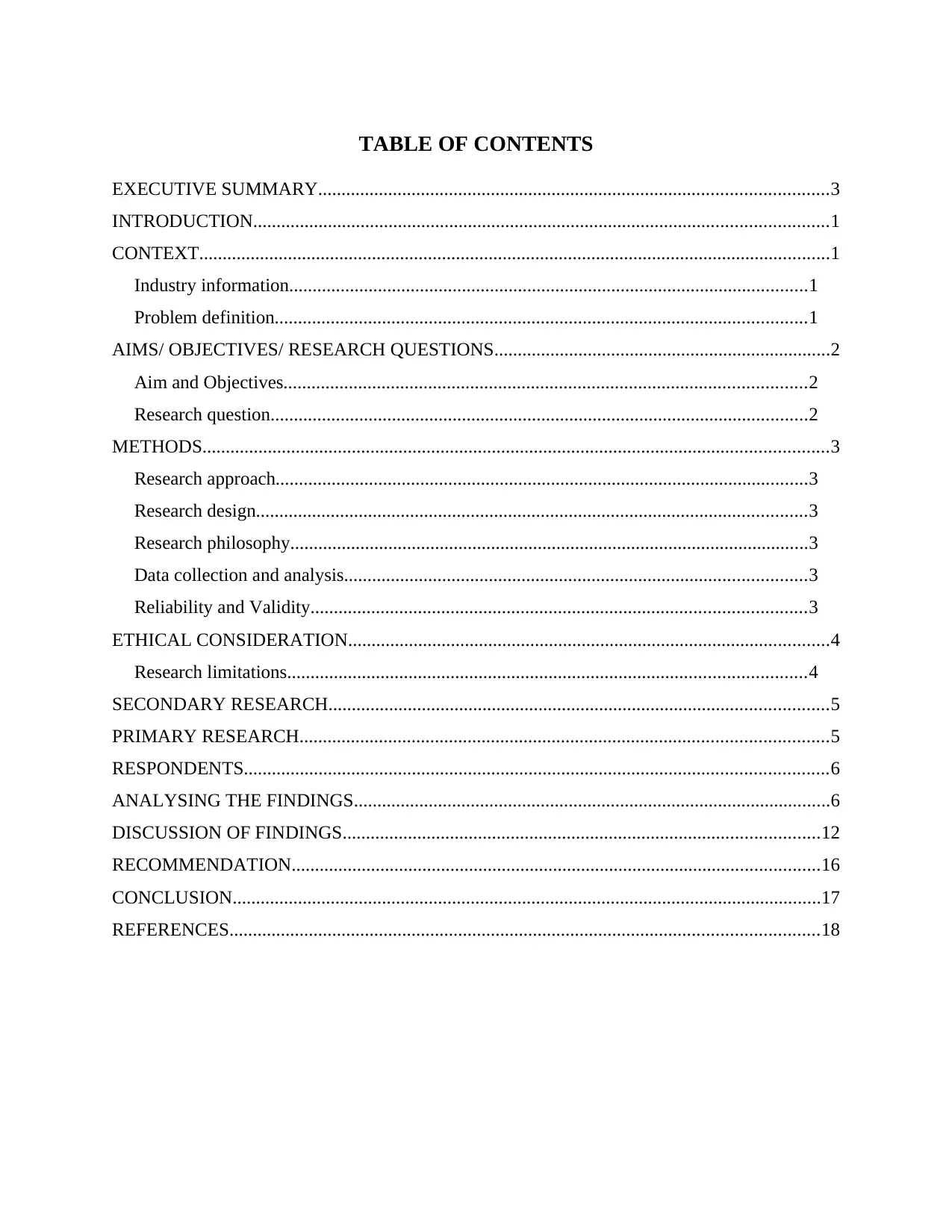
TABLE OF CONTENTS
EXECUTIVE SUMMARY.............................................................................................................3
INTRODUCTION...........................................................................................................................1
CONTEXT.......................................................................................................................................1
Industry information...............................................................................................................1
Problem definition..................................................................................................................1
AIMS/ OBJECTIVES/ RESEARCH QUESTIONS........................................................................2
Aim and Objectives................................................................................................................2
Research question...................................................................................................................2
METHODS......................................................................................................................................3
Research approach..................................................................................................................3
Research design......................................................................................................................3
Research philosophy...............................................................................................................3
Data collection and analysis...................................................................................................3
Reliability and Validity..........................................................................................................3
ETHICAL CONSIDERATION.......................................................................................................4
Research limitations...............................................................................................................4
SECONDARY RESEARCH...........................................................................................................5
PRIMARY RESEARCH.................................................................................................................5
RESPONDENTS.............................................................................................................................6
ANALYSING THE FINDINGS......................................................................................................6
DISCUSSION OF FINDINGS......................................................................................................12
RECOMMENDATION.................................................................................................................16
CONCLUSION..............................................................................................................................17
REFERENCES..............................................................................................................................18
EXECUTIVE SUMMARY.............................................................................................................3
INTRODUCTION...........................................................................................................................1
CONTEXT.......................................................................................................................................1
Industry information...............................................................................................................1
Problem definition..................................................................................................................1
AIMS/ OBJECTIVES/ RESEARCH QUESTIONS........................................................................2
Aim and Objectives................................................................................................................2
Research question...................................................................................................................2
METHODS......................................................................................................................................3
Research approach..................................................................................................................3
Research design......................................................................................................................3
Research philosophy...............................................................................................................3
Data collection and analysis...................................................................................................3
Reliability and Validity..........................................................................................................3
ETHICAL CONSIDERATION.......................................................................................................4
Research limitations...............................................................................................................4
SECONDARY RESEARCH...........................................................................................................5
PRIMARY RESEARCH.................................................................................................................5
RESPONDENTS.............................................................................................................................6
ANALYSING THE FINDINGS......................................................................................................6
DISCUSSION OF FINDINGS......................................................................................................12
RECOMMENDATION.................................................................................................................16
CONCLUSION..............................................................................................................................17
REFERENCES..............................................................................................................................18
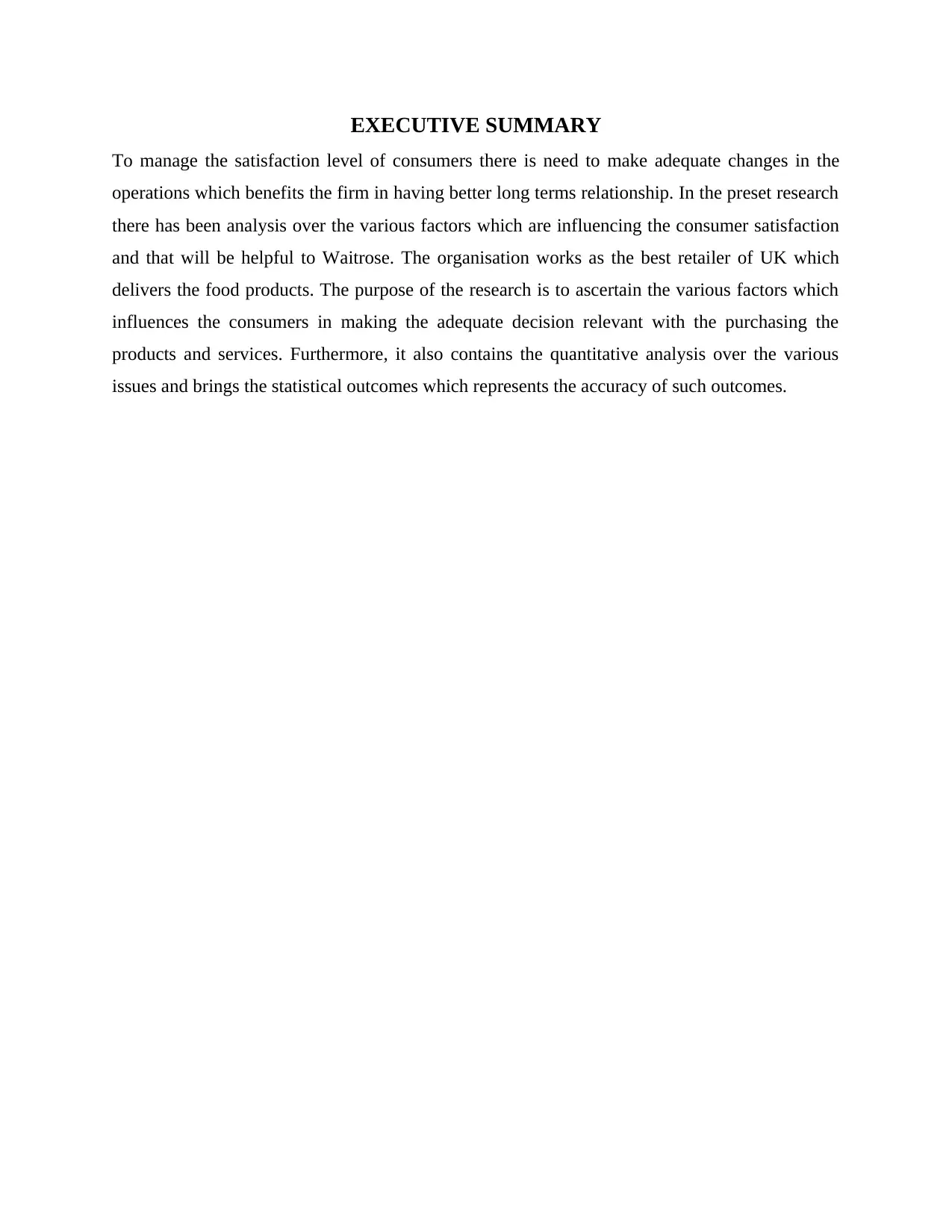
EXECUTIVE SUMMARY
To manage the satisfaction level of consumers there is need to make adequate changes in the
operations which benefits the firm in having better long terms relationship. In the preset research
there has been analysis over the various factors which are influencing the consumer satisfaction
and that will be helpful to Waitrose. The organisation works as the best retailer of UK which
delivers the food products. The purpose of the research is to ascertain the various factors which
influences the consumers in making the adequate decision relevant with the purchasing the
products and services. Furthermore, it also contains the quantitative analysis over the various
issues and brings the statistical outcomes which represents the accuracy of such outcomes.
To manage the satisfaction level of consumers there is need to make adequate changes in the
operations which benefits the firm in having better long terms relationship. In the preset research
there has been analysis over the various factors which are influencing the consumer satisfaction
and that will be helpful to Waitrose. The organisation works as the best retailer of UK which
delivers the food products. The purpose of the research is to ascertain the various factors which
influences the consumers in making the adequate decision relevant with the purchasing the
products and services. Furthermore, it also contains the quantitative analysis over the various
issues and brings the statistical outcomes which represents the accuracy of such outcomes.
⊘ This is a preview!⊘
Do you want full access?
Subscribe today to unlock all pages.

Trusted by 1+ million students worldwide
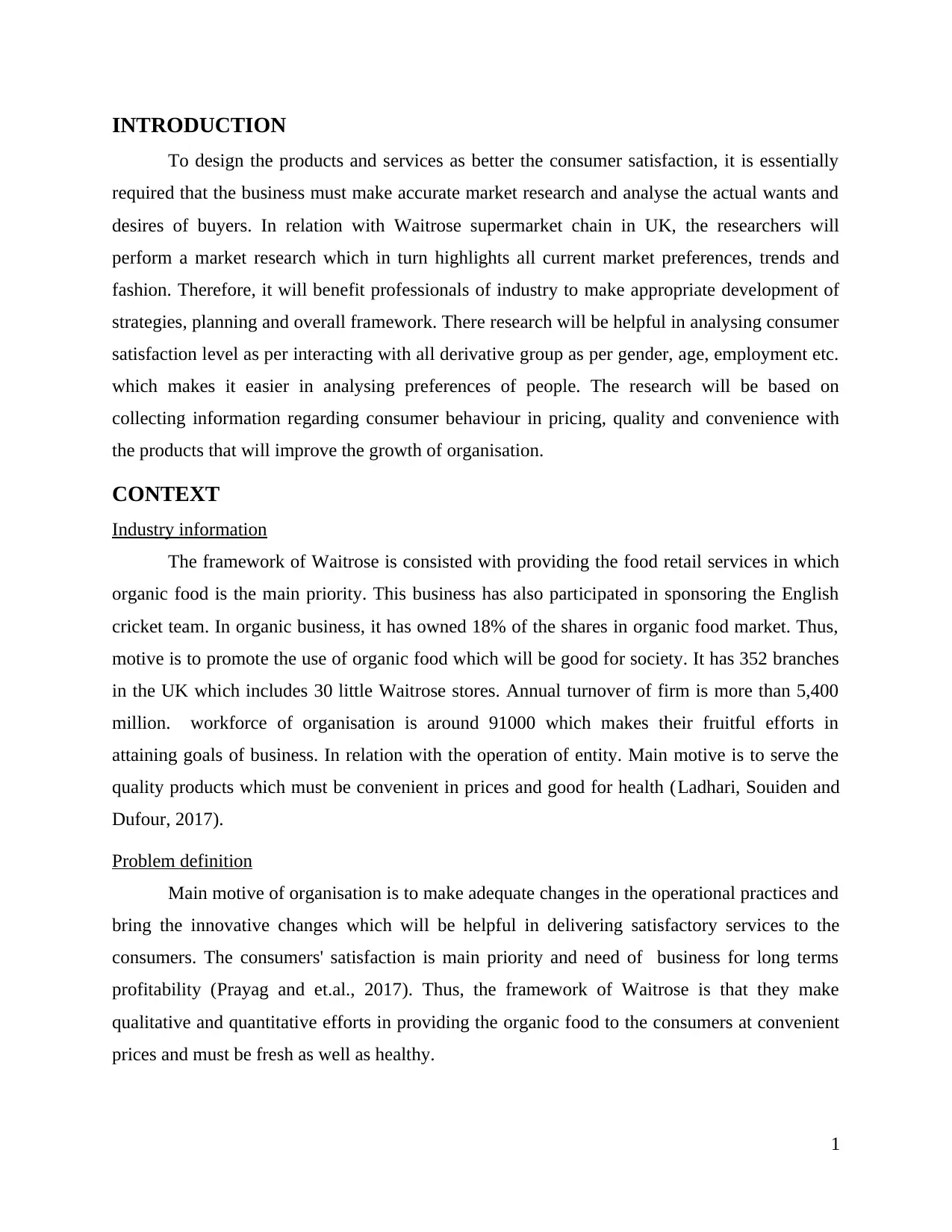
INTRODUCTION
To design the products and services as better the consumer satisfaction, it is essentially
required that the business must make accurate market research and analyse the actual wants and
desires of buyers. In relation with Waitrose supermarket chain in UK, the researchers will
perform a market research which in turn highlights all current market preferences, trends and
fashion. Therefore, it will benefit professionals of industry to make appropriate development of
strategies, planning and overall framework. There research will be helpful in analysing consumer
satisfaction level as per interacting with all derivative group as per gender, age, employment etc.
which makes it easier in analysing preferences of people. The research will be based on
collecting information regarding consumer behaviour in pricing, quality and convenience with
the products that will improve the growth of organisation.
CONTEXT
Industry information
The framework of Waitrose is consisted with providing the food retail services in which
organic food is the main priority. This business has also participated in sponsoring the English
cricket team. In organic business, it has owned 18% of the shares in organic food market. Thus,
motive is to promote the use of organic food which will be good for society. It has 352 branches
in the UK which includes 30 little Waitrose stores. Annual turnover of firm is more than 5,400
million. workforce of organisation is around 91000 which makes their fruitful efforts in
attaining goals of business. In relation with the operation of entity. Main motive is to serve the
quality products which must be convenient in prices and good for health (Ladhari, Souiden and
Dufour, 2017).
Problem definition
Main motive of organisation is to make adequate changes in the operational practices and
bring the innovative changes which will be helpful in delivering satisfactory services to the
consumers. The consumers' satisfaction is main priority and need of business for long terms
profitability (Prayag and et.al., 2017). Thus, the framework of Waitrose is that they make
qualitative and quantitative efforts in providing the organic food to the consumers at convenient
prices and must be fresh as well as healthy.
1
To design the products and services as better the consumer satisfaction, it is essentially
required that the business must make accurate market research and analyse the actual wants and
desires of buyers. In relation with Waitrose supermarket chain in UK, the researchers will
perform a market research which in turn highlights all current market preferences, trends and
fashion. Therefore, it will benefit professionals of industry to make appropriate development of
strategies, planning and overall framework. There research will be helpful in analysing consumer
satisfaction level as per interacting with all derivative group as per gender, age, employment etc.
which makes it easier in analysing preferences of people. The research will be based on
collecting information regarding consumer behaviour in pricing, quality and convenience with
the products that will improve the growth of organisation.
CONTEXT
Industry information
The framework of Waitrose is consisted with providing the food retail services in which
organic food is the main priority. This business has also participated in sponsoring the English
cricket team. In organic business, it has owned 18% of the shares in organic food market. Thus,
motive is to promote the use of organic food which will be good for society. It has 352 branches
in the UK which includes 30 little Waitrose stores. Annual turnover of firm is more than 5,400
million. workforce of organisation is around 91000 which makes their fruitful efforts in
attaining goals of business. In relation with the operation of entity. Main motive is to serve the
quality products which must be convenient in prices and good for health (Ladhari, Souiden and
Dufour, 2017).
Problem definition
Main motive of organisation is to make adequate changes in the operational practices and
bring the innovative changes which will be helpful in delivering satisfactory services to the
consumers. The consumers' satisfaction is main priority and need of business for long terms
profitability (Prayag and et.al., 2017). Thus, the framework of Waitrose is that they make
qualitative and quantitative efforts in providing the organic food to the consumers at convenient
prices and must be fresh as well as healthy.
1
Paraphrase This Document
Need a fresh take? Get an instant paraphrase of this document with our AI Paraphraser
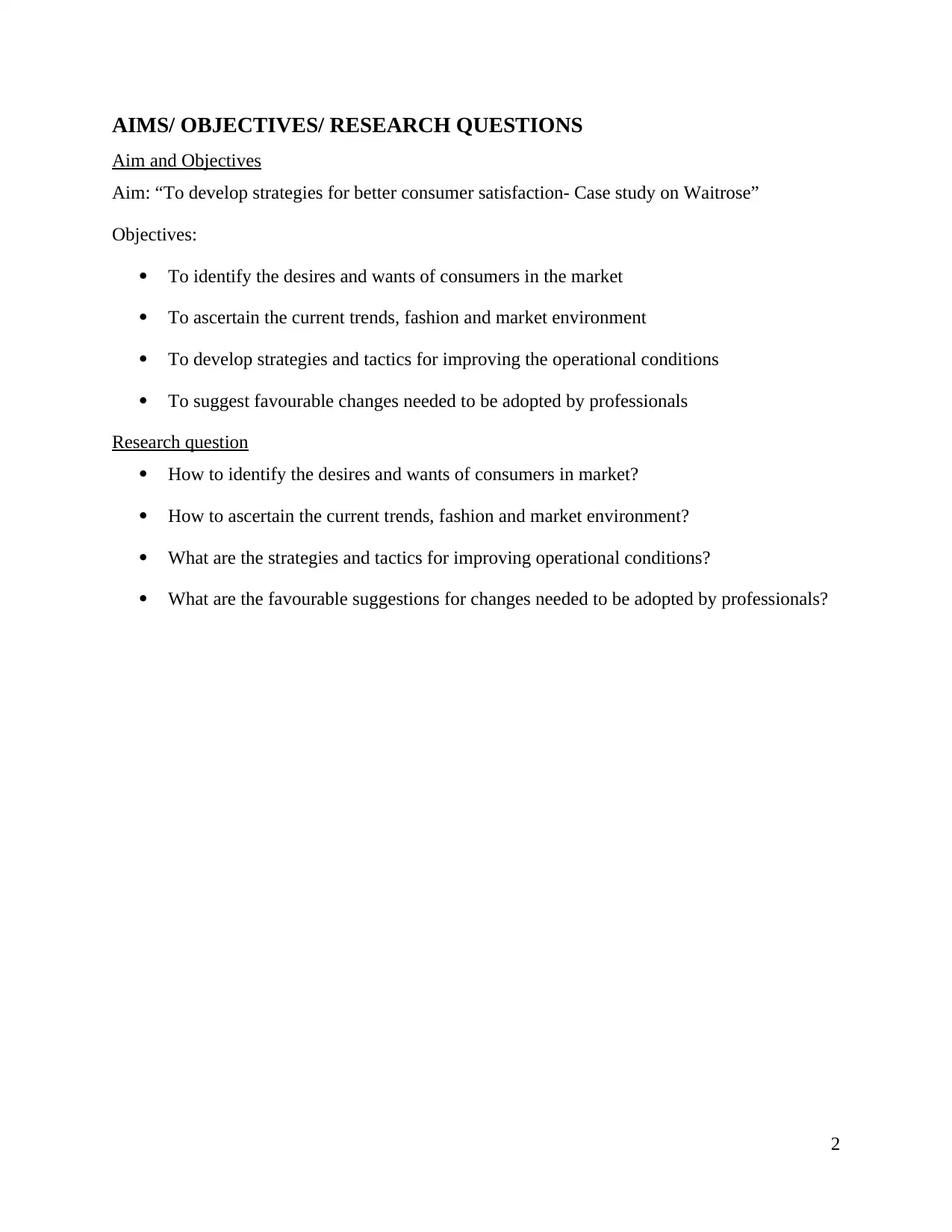
AIMS/ OBJECTIVES/ RESEARCH QUESTIONS
Aim and Objectives
Aim: “To develop strategies for better consumer satisfaction- Case study on Waitrose”
Objectives:
To identify the desires and wants of consumers in the market
To ascertain the current trends, fashion and market environment
To develop strategies and tactics for improving the operational conditions
To suggest favourable changes needed to be adopted by professionals
Research question
How to identify the desires and wants of consumers in market?
How to ascertain the current trends, fashion and market environment?
What are the strategies and tactics for improving operational conditions?
What are the favourable suggestions for changes needed to be adopted by professionals?
2
Aim and Objectives
Aim: “To develop strategies for better consumer satisfaction- Case study on Waitrose”
Objectives:
To identify the desires and wants of consumers in the market
To ascertain the current trends, fashion and market environment
To develop strategies and tactics for improving the operational conditions
To suggest favourable changes needed to be adopted by professionals
Research question
How to identify the desires and wants of consumers in market?
How to ascertain the current trends, fashion and market environment?
What are the strategies and tactics for improving operational conditions?
What are the favourable suggestions for changes needed to be adopted by professionals?
2
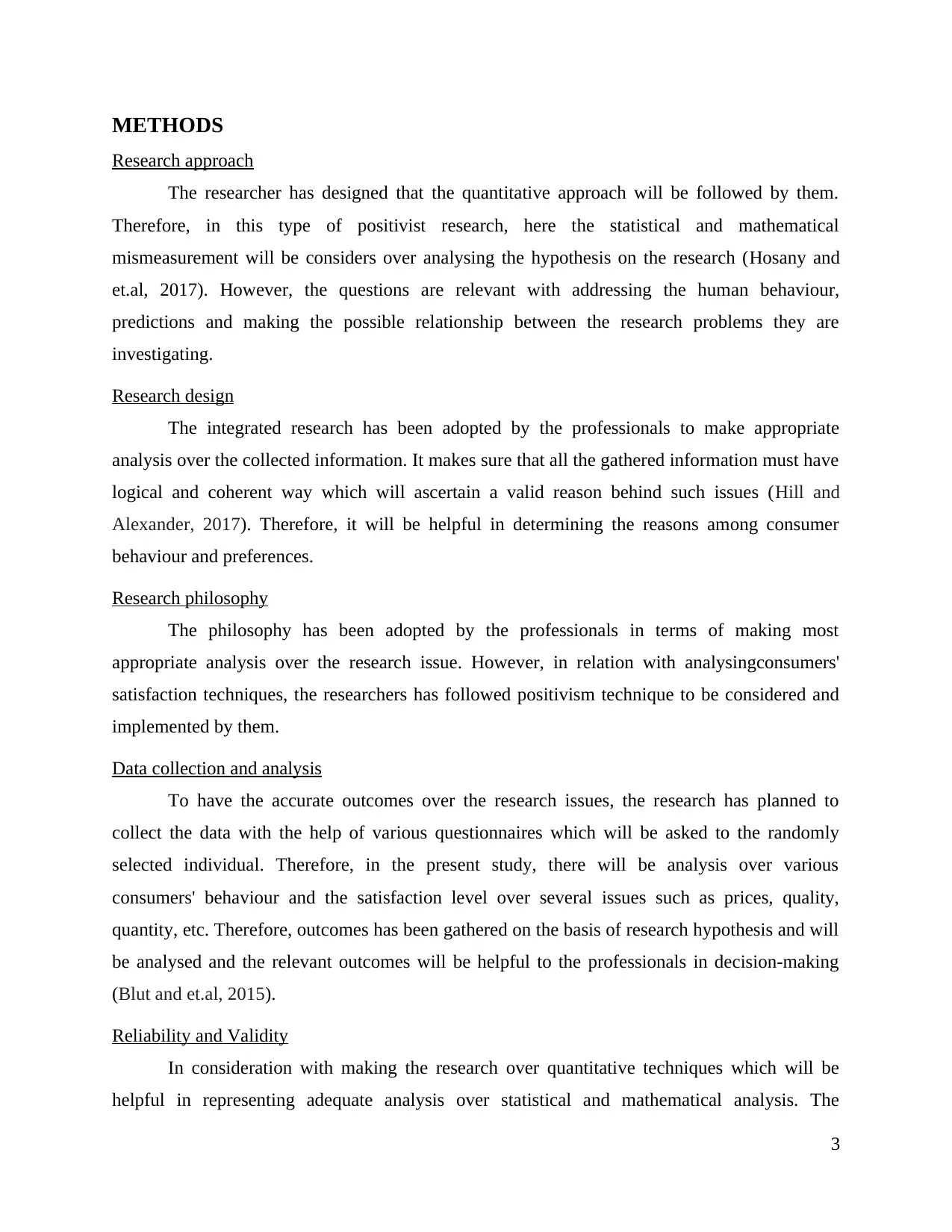
METHODS
Research approach
The researcher has designed that the quantitative approach will be followed by them.
Therefore, in this type of positivist research, here the statistical and mathematical
mismeasurement will be considers over analysing the hypothesis on the research (Hosany and
et.al, 2017). However, the questions are relevant with addressing the human behaviour,
predictions and making the possible relationship between the research problems they are
investigating.
Research design
The integrated research has been adopted by the professionals to make appropriate
analysis over the collected information. It makes sure that all the gathered information must have
logical and coherent way which will ascertain a valid reason behind such issues (Hill and
Alexander, 2017). Therefore, it will be helpful in determining the reasons among consumer
behaviour and preferences.
Research philosophy
The philosophy has been adopted by the professionals in terms of making most
appropriate analysis over the research issue. However, in relation with analysingconsumers'
satisfaction techniques, the researchers has followed positivism technique to be considered and
implemented by them.
Data collection and analysis
To have the accurate outcomes over the research issues, the research has planned to
collect the data with the help of various questionnaires which will be asked to the randomly
selected individual. Therefore, in the present study, there will be analysis over various
consumers' behaviour and the satisfaction level over several issues such as prices, quality,
quantity, etc. Therefore, outcomes has been gathered on the basis of research hypothesis and will
be analysed and the relevant outcomes will be helpful to the professionals in decision-making
(Blut and et.al, 2015).
Reliability and Validity
In consideration with making the research over quantitative techniques which will be
helpful in representing adequate analysis over statistical and mathematical analysis. The
3
Research approach
The researcher has designed that the quantitative approach will be followed by them.
Therefore, in this type of positivist research, here the statistical and mathematical
mismeasurement will be considers over analysing the hypothesis on the research (Hosany and
et.al, 2017). However, the questions are relevant with addressing the human behaviour,
predictions and making the possible relationship between the research problems they are
investigating.
Research design
The integrated research has been adopted by the professionals to make appropriate
analysis over the collected information. It makes sure that all the gathered information must have
logical and coherent way which will ascertain a valid reason behind such issues (Hill and
Alexander, 2017). Therefore, it will be helpful in determining the reasons among consumer
behaviour and preferences.
Research philosophy
The philosophy has been adopted by the professionals in terms of making most
appropriate analysis over the research issue. However, in relation with analysingconsumers'
satisfaction techniques, the researchers has followed positivism technique to be considered and
implemented by them.
Data collection and analysis
To have the accurate outcomes over the research issues, the research has planned to
collect the data with the help of various questionnaires which will be asked to the randomly
selected individual. Therefore, in the present study, there will be analysis over various
consumers' behaviour and the satisfaction level over several issues such as prices, quality,
quantity, etc. Therefore, outcomes has been gathered on the basis of research hypothesis and will
be analysed and the relevant outcomes will be helpful to the professionals in decision-making
(Blut and et.al, 2015).
Reliability and Validity
In consideration with making the research over quantitative techniques which will be
helpful in representing adequate analysis over statistical and mathematical analysis. The
3
⊘ This is a preview!⊘
Do you want full access?
Subscribe today to unlock all pages.

Trusted by 1+ million students worldwide
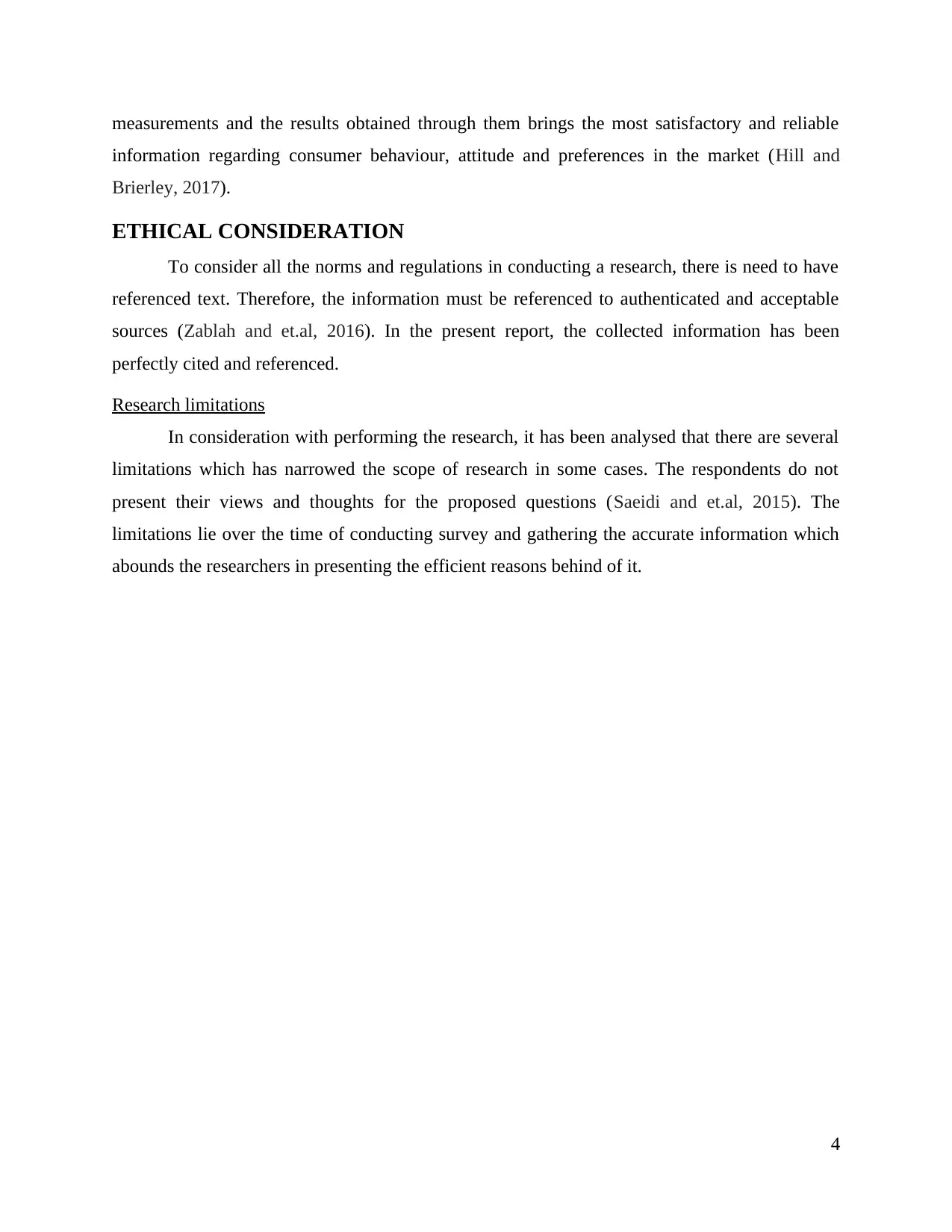
measurements and the results obtained through them brings the most satisfactory and reliable
information regarding consumer behaviour, attitude and preferences in the market (Hill and
Brierley, 2017).
ETHICAL CONSIDERATION
To consider all the norms and regulations in conducting a research, there is need to have
referenced text. Therefore, the information must be referenced to authenticated and acceptable
sources (Zablah and et.al, 2016). In the present report, the collected information has been
perfectly cited and referenced.
Research limitations
In consideration with performing the research, it has been analysed that there are several
limitations which has narrowed the scope of research in some cases. The respondents do not
present their views and thoughts for the proposed questions (Saeidi and et.al, 2015). The
limitations lie over the time of conducting survey and gathering the accurate information which
abounds the researchers in presenting the efficient reasons behind of it.
4
information regarding consumer behaviour, attitude and preferences in the market (Hill and
Brierley, 2017).
ETHICAL CONSIDERATION
To consider all the norms and regulations in conducting a research, there is need to have
referenced text. Therefore, the information must be referenced to authenticated and acceptable
sources (Zablah and et.al, 2016). In the present report, the collected information has been
perfectly cited and referenced.
Research limitations
In consideration with performing the research, it has been analysed that there are several
limitations which has narrowed the scope of research in some cases. The respondents do not
present their views and thoughts for the proposed questions (Saeidi and et.al, 2015). The
limitations lie over the time of conducting survey and gathering the accurate information which
abounds the researchers in presenting the efficient reasons behind of it.
4
Paraphrase This Document
Need a fresh take? Get an instant paraphrase of this document with our AI Paraphraser
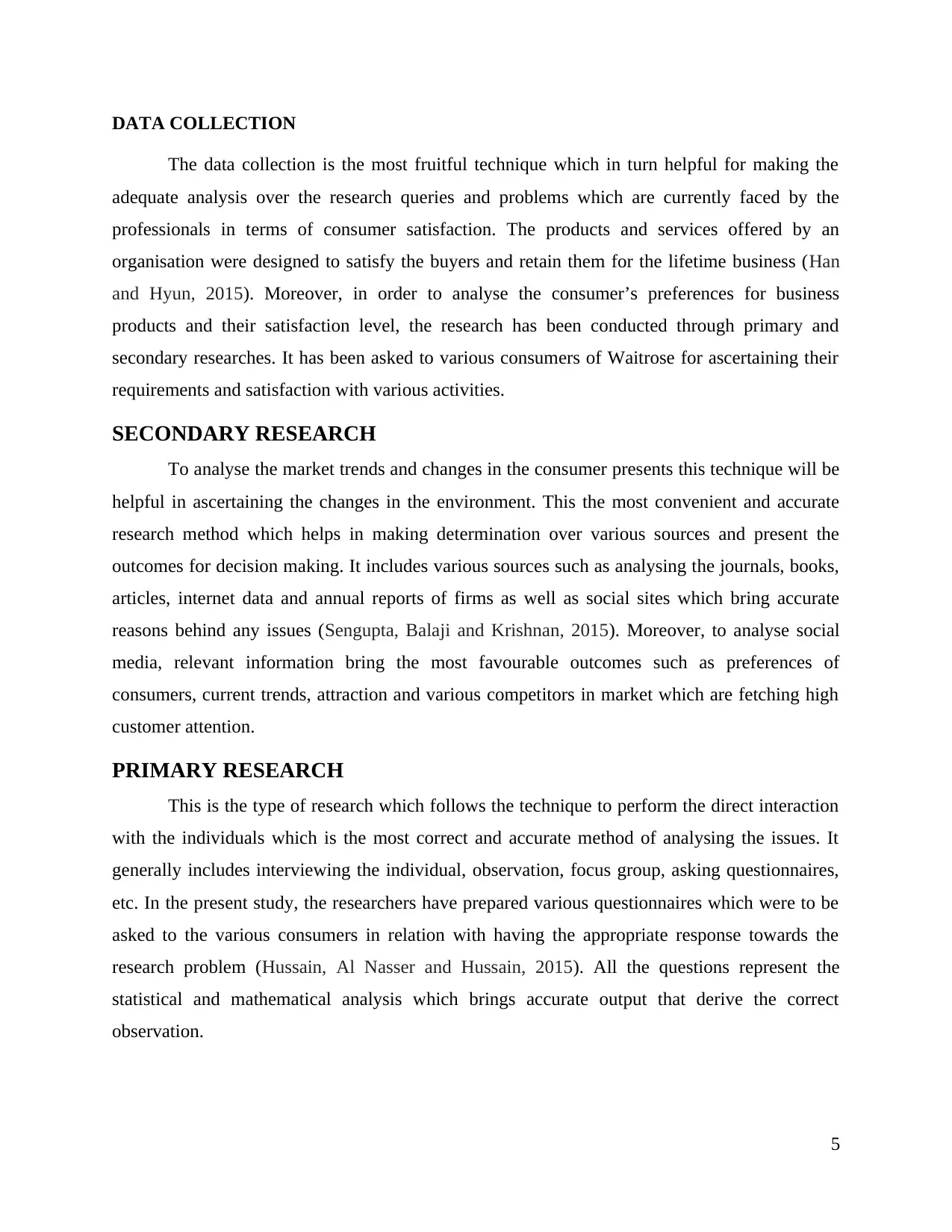
DATA COLLECTION
The data collection is the most fruitful technique which in turn helpful for making the
adequate analysis over the research queries and problems which are currently faced by the
professionals in terms of consumer satisfaction. The products and services offered by an
organisation were designed to satisfy the buyers and retain them for the lifetime business (Han
and Hyun, 2015). Moreover, in order to analyse the consumer’s preferences for business
products and their satisfaction level, the research has been conducted through primary and
secondary researches. It has been asked to various consumers of Waitrose for ascertaining their
requirements and satisfaction with various activities.
SECONDARY RESEARCH
To analyse the market trends and changes in the consumer presents this technique will be
helpful in ascertaining the changes in the environment. This the most convenient and accurate
research method which helps in making determination over various sources and present the
outcomes for decision making. It includes various sources such as analysing the journals, books,
articles, internet data and annual reports of firms as well as social sites which bring accurate
reasons behind any issues (Sengupta, Balaji and Krishnan, 2015). Moreover, to analyse social
media, relevant information bring the most favourable outcomes such as preferences of
consumers, current trends, attraction and various competitors in market which are fetching high
customer attention.
PRIMARY RESEARCH
This is the type of research which follows the technique to perform the direct interaction
with the individuals which is the most correct and accurate method of analysing the issues. It
generally includes interviewing the individual, observation, focus group, asking questionnaires,
etc. In the present study, the researchers have prepared various questionnaires which were to be
asked to the various consumers in relation with having the appropriate response towards the
research problem (Hussain, Al Nasser and Hussain, 2015). All the questions represent the
statistical and mathematical analysis which brings accurate output that derive the correct
observation.
5
The data collection is the most fruitful technique which in turn helpful for making the
adequate analysis over the research queries and problems which are currently faced by the
professionals in terms of consumer satisfaction. The products and services offered by an
organisation were designed to satisfy the buyers and retain them for the lifetime business (Han
and Hyun, 2015). Moreover, in order to analyse the consumer’s preferences for business
products and their satisfaction level, the research has been conducted through primary and
secondary researches. It has been asked to various consumers of Waitrose for ascertaining their
requirements and satisfaction with various activities.
SECONDARY RESEARCH
To analyse the market trends and changes in the consumer presents this technique will be
helpful in ascertaining the changes in the environment. This the most convenient and accurate
research method which helps in making determination over various sources and present the
outcomes for decision making. It includes various sources such as analysing the journals, books,
articles, internet data and annual reports of firms as well as social sites which bring accurate
reasons behind any issues (Sengupta, Balaji and Krishnan, 2015). Moreover, to analyse social
media, relevant information bring the most favourable outcomes such as preferences of
consumers, current trends, attraction and various competitors in market which are fetching high
customer attention.
PRIMARY RESEARCH
This is the type of research which follows the technique to perform the direct interaction
with the individuals which is the most correct and accurate method of analysing the issues. It
generally includes interviewing the individual, observation, focus group, asking questionnaires,
etc. In the present study, the researchers have prepared various questionnaires which were to be
asked to the various consumers in relation with having the appropriate response towards the
research problem (Hussain, Al Nasser and Hussain, 2015). All the questions represent the
statistical and mathematical analysis which brings accurate output that derive the correct
observation.
5
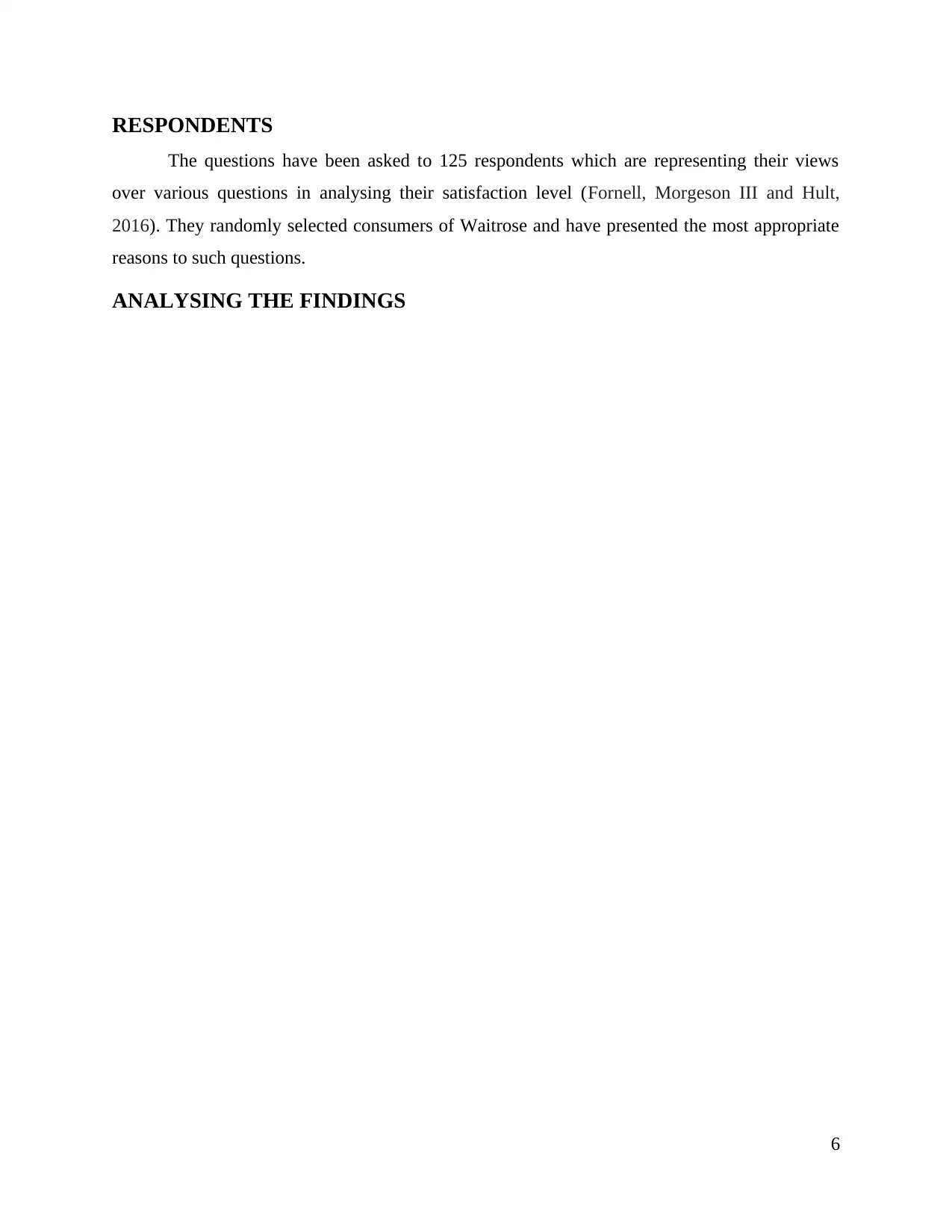
RESPONDENTS
The questions have been asked to 125 respondents which are representing their views
over various questions in analysing their satisfaction level (Fornell, Morgeson III and Hult,
2016). They randomly selected consumers of Waitrose and have presented the most appropriate
reasons to such questions.
ANALYSING THE FINDINGS
6
The questions have been asked to 125 respondents which are representing their views
over various questions in analysing their satisfaction level (Fornell, Morgeson III and Hult,
2016). They randomly selected consumers of Waitrose and have presented the most appropriate
reasons to such questions.
ANALYSING THE FINDINGS
6
⊘ This is a preview!⊘
Do you want full access?
Subscribe today to unlock all pages.

Trusted by 1+ million students worldwide
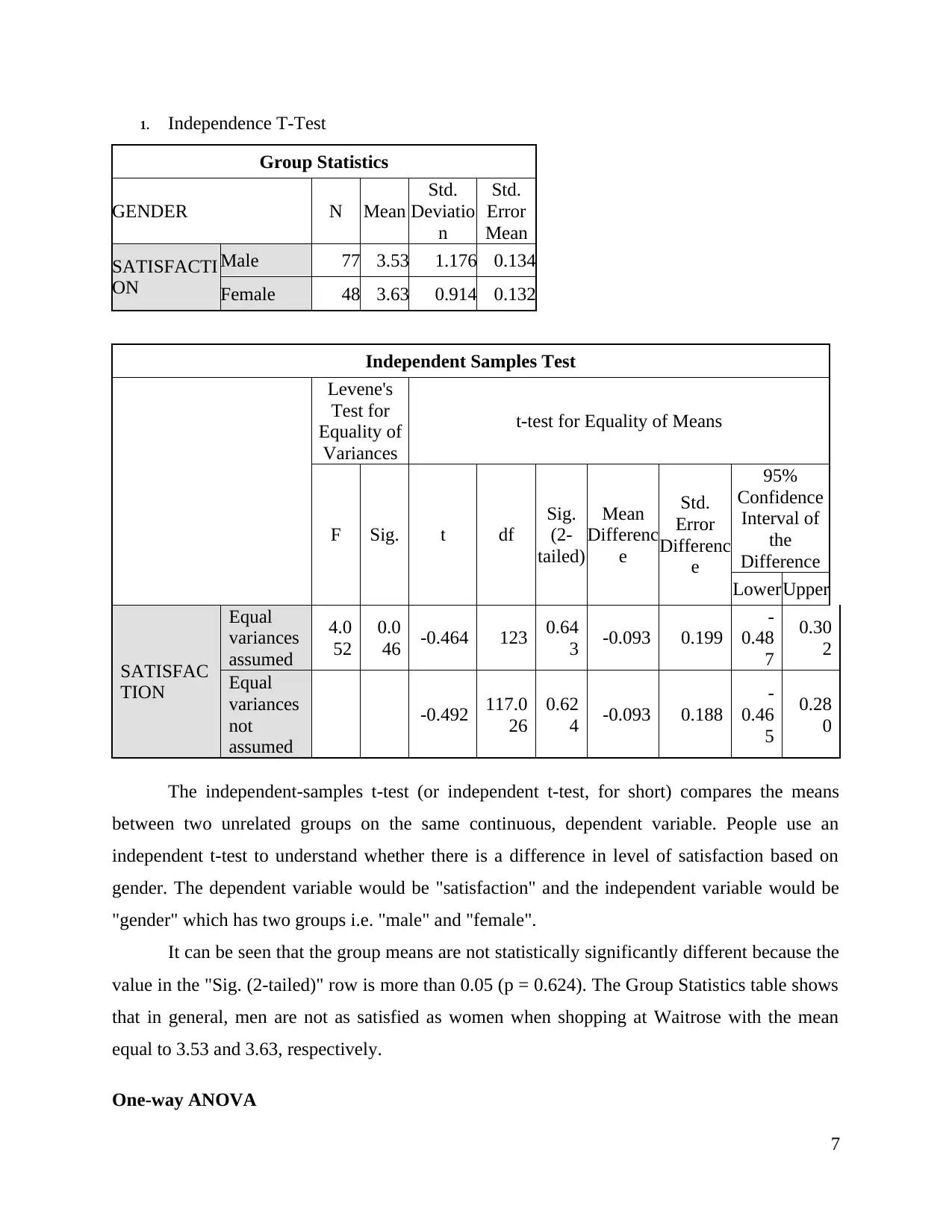
1. Independence T-Test
Group Statistics
GENDER N Mean
Std.
Deviatio
n
Std.
Error
Mean
SATISFACTI
ON
Male 77 3.53 1.176 0.134
Female 48 3.63 0.914 0.132
Independent Samples Test
Levene's
Test for
Equality of
Variances
t-test for Equality of Means
F Sig. t df
Sig.
(2-
tailed)
Mean
Differenc
e
Std.
Error
Differenc
e
95%
Confidence
Interval of
the
Difference
LowerUpper
SATISFAC
TION
Equal
variances
assumed
4.0
52
0.0
46 -0.464 123 0.64
3 -0.093 0.199
-
0.48
7
0.30
2
Equal
variances
not
assumed
-0.492 117.0
26
0.62
4 -0.093 0.188
-
0.46
5
0.28
0
The independent-samples t-test (or independent t-test, for short) compares the means
between two unrelated groups on the same continuous, dependent variable. People use an
independent t-test to understand whether there is a difference in level of satisfaction based on
gender. The dependent variable would be "satisfaction" and the independent variable would be
"gender" which has two groups i.e. "male" and "female".
It can be seen that the group means are not statistically significantly different because the
value in the "Sig. (2-tailed)" row is more than 0.05 (p = 0.624). The Group Statistics table shows
that in general, men are not as satisfied as women when shopping at Waitrose with the mean
equal to 3.53 and 3.63, respectively.
One-way ANOVA
7
Group Statistics
GENDER N Mean
Std.
Deviatio
n
Std.
Error
Mean
SATISFACTI
ON
Male 77 3.53 1.176 0.134
Female 48 3.63 0.914 0.132
Independent Samples Test
Levene's
Test for
Equality of
Variances
t-test for Equality of Means
F Sig. t df
Sig.
(2-
tailed)
Mean
Differenc
e
Std.
Error
Differenc
e
95%
Confidence
Interval of
the
Difference
LowerUpper
SATISFAC
TION
Equal
variances
assumed
4.0
52
0.0
46 -0.464 123 0.64
3 -0.093 0.199
-
0.48
7
0.30
2
Equal
variances
not
assumed
-0.492 117.0
26
0.62
4 -0.093 0.188
-
0.46
5
0.28
0
The independent-samples t-test (or independent t-test, for short) compares the means
between two unrelated groups on the same continuous, dependent variable. People use an
independent t-test to understand whether there is a difference in level of satisfaction based on
gender. The dependent variable would be "satisfaction" and the independent variable would be
"gender" which has two groups i.e. "male" and "female".
It can be seen that the group means are not statistically significantly different because the
value in the "Sig. (2-tailed)" row is more than 0.05 (p = 0.624). The Group Statistics table shows
that in general, men are not as satisfied as women when shopping at Waitrose with the mean
equal to 3.53 and 3.63, respectively.
One-way ANOVA
7
Paraphrase This Document
Need a fresh take? Get an instant paraphrase of this document with our AI Paraphraser
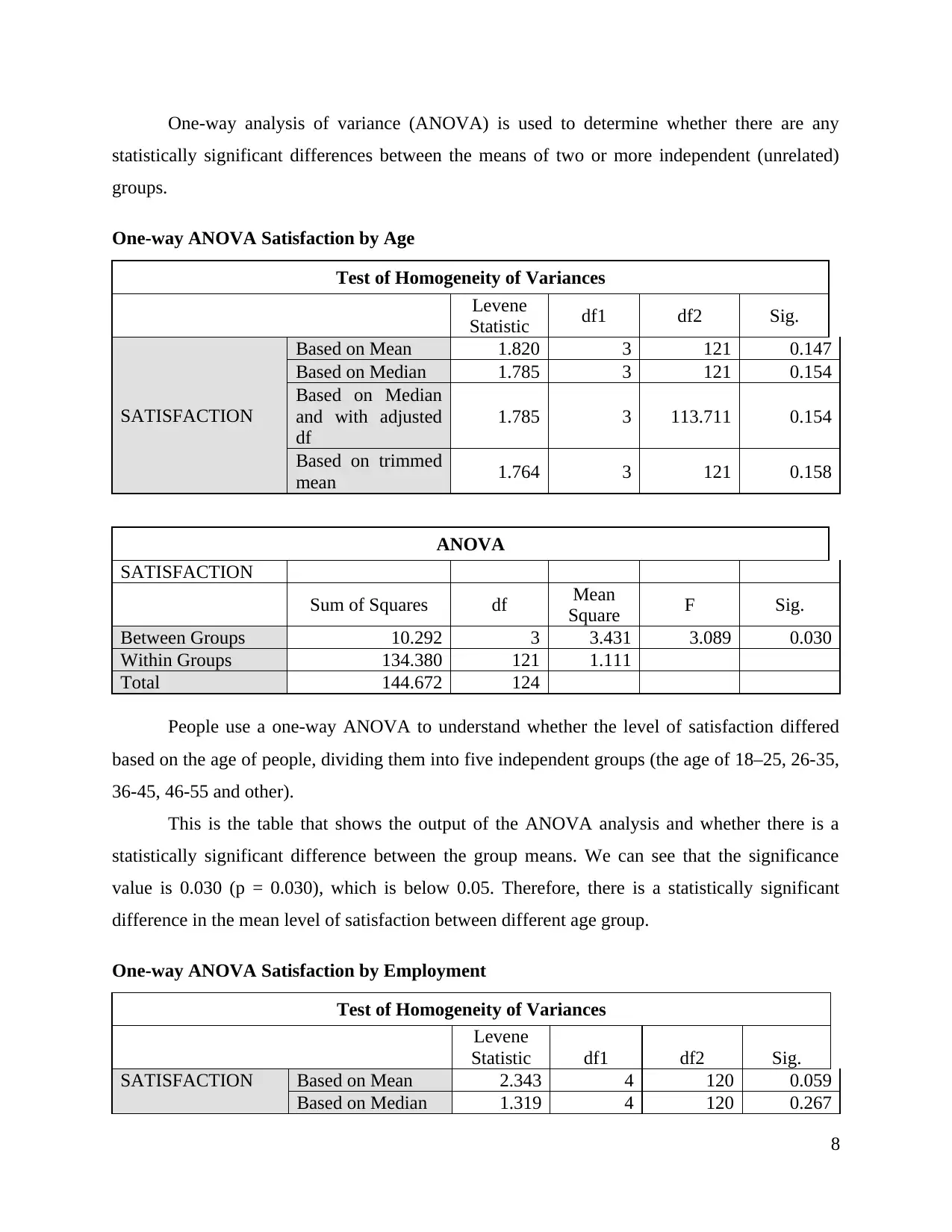
One-way analysis of variance (ANOVA) is used to determine whether there are any
statistically significant differences between the means of two or more independent (unrelated)
groups.
One-way ANOVA Satisfaction by Age
Test of Homogeneity of Variances
Levene
Statistic df1 df2 Sig.
SATISFACTION
Based on Mean 1.820 3 121 0.147
Based on Median 1.785 3 121 0.154
Based on Median
and with adjusted
df
1.785 3 113.711 0.154
Based on trimmed
mean 1.764 3 121 0.158
ANOVA
SATISFACTION
Sum of Squares df Mean
Square F Sig.
Between Groups 10.292 3 3.431 3.089 0.030
Within Groups 134.380 121 1.111
Total 144.672 124
People use a one-way ANOVA to understand whether the level of satisfaction differed
based on the age of people, dividing them into five independent groups (the age of 18–25, 26-35,
36-45, 46-55 and other).
This is the table that shows the output of the ANOVA analysis and whether there is a
statistically significant difference between the group means. We can see that the significance
value is 0.030 (p = 0.030), which is below 0.05. Therefore, there is a statistically significant
difference in the mean level of satisfaction between different age group.
One-way ANOVA Satisfaction by Employment
Test of Homogeneity of Variances
Levene
Statistic df1 df2 Sig.
SATISFACTION Based on Mean 2.343 4 120 0.059
Based on Median 1.319 4 120 0.267
8
statistically significant differences between the means of two or more independent (unrelated)
groups.
One-way ANOVA Satisfaction by Age
Test of Homogeneity of Variances
Levene
Statistic df1 df2 Sig.
SATISFACTION
Based on Mean 1.820 3 121 0.147
Based on Median 1.785 3 121 0.154
Based on Median
and with adjusted
df
1.785 3 113.711 0.154
Based on trimmed
mean 1.764 3 121 0.158
ANOVA
SATISFACTION
Sum of Squares df Mean
Square F Sig.
Between Groups 10.292 3 3.431 3.089 0.030
Within Groups 134.380 121 1.111
Total 144.672 124
People use a one-way ANOVA to understand whether the level of satisfaction differed
based on the age of people, dividing them into five independent groups (the age of 18–25, 26-35,
36-45, 46-55 and other).
This is the table that shows the output of the ANOVA analysis and whether there is a
statistically significant difference between the group means. We can see that the significance
value is 0.030 (p = 0.030), which is below 0.05. Therefore, there is a statistically significant
difference in the mean level of satisfaction between different age group.
One-way ANOVA Satisfaction by Employment
Test of Homogeneity of Variances
Levene
Statistic df1 df2 Sig.
SATISFACTION Based on Mean 2.343 4 120 0.059
Based on Median 1.319 4 120 0.267
8
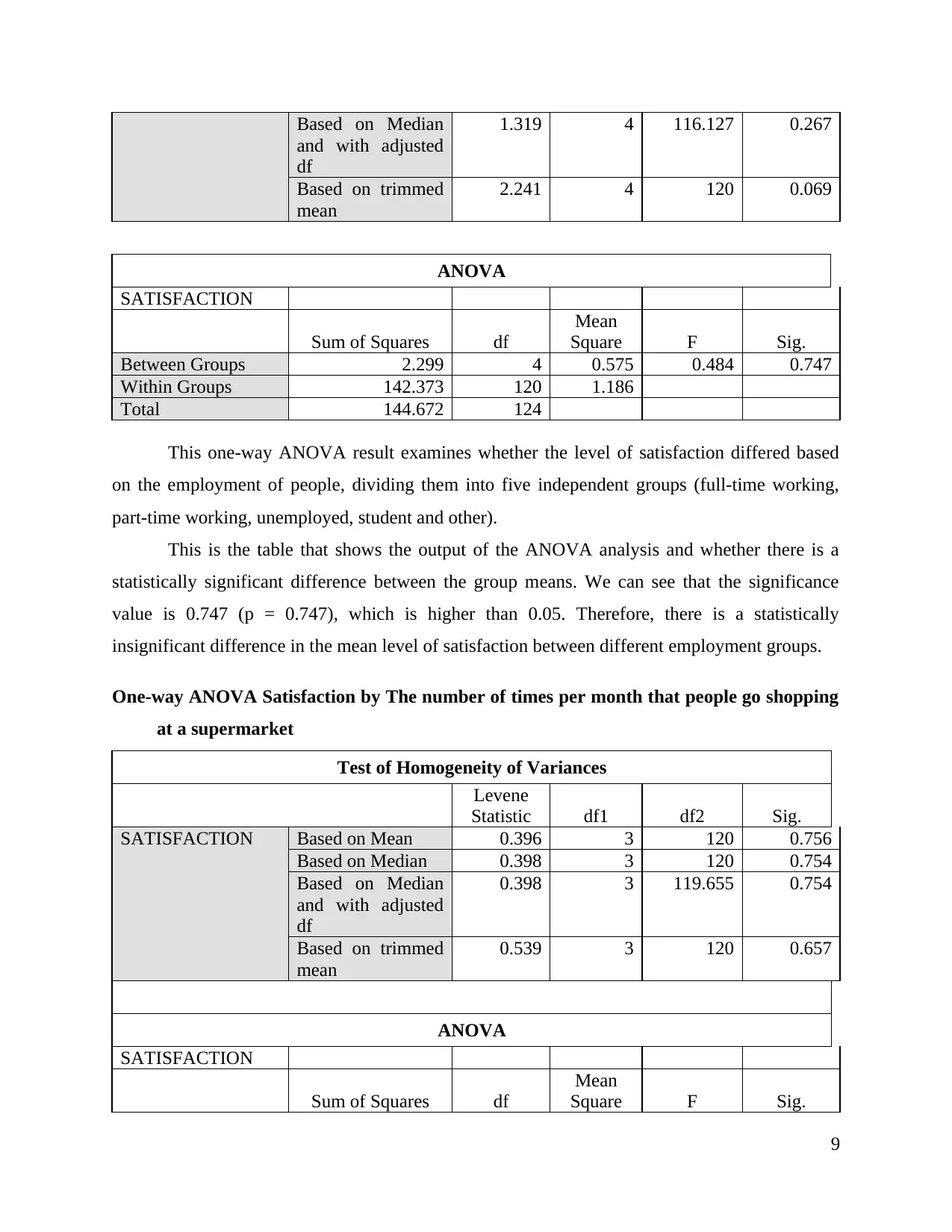
Based on Median
and with adjusted
df
1.319 4 116.127 0.267
Based on trimmed
mean
2.241 4 120 0.069
ANOVA
SATISFACTION
Sum of Squares df
Mean
Square F Sig.
Between Groups 2.299 4 0.575 0.484 0.747
Within Groups 142.373 120 1.186
Total 144.672 124
This one-way ANOVA result examines whether the level of satisfaction differed based
on the employment of people, dividing them into five independent groups (full-time working,
part-time working, unemployed, student and other).
This is the table that shows the output of the ANOVA analysis and whether there is a
statistically significant difference between the group means. We can see that the significance
value is 0.747 (p = 0.747), which is higher than 0.05. Therefore, there is a statistically
insignificant difference in the mean level of satisfaction between different employment groups.
One-way ANOVA Satisfaction by The number of times per month that people go shopping
at a supermarket
Test of Homogeneity of Variances
Levene
Statistic df1 df2 Sig.
SATISFACTION Based on Mean 0.396 3 120 0.756
Based on Median 0.398 3 120 0.754
Based on Median
and with adjusted
df
0.398 3 119.655 0.754
Based on trimmed
mean
0.539 3 120 0.657
ANOVA
SATISFACTION
Sum of Squares df
Mean
Square F Sig.
9
and with adjusted
df
1.319 4 116.127 0.267
Based on trimmed
mean
2.241 4 120 0.069
ANOVA
SATISFACTION
Sum of Squares df
Mean
Square F Sig.
Between Groups 2.299 4 0.575 0.484 0.747
Within Groups 142.373 120 1.186
Total 144.672 124
This one-way ANOVA result examines whether the level of satisfaction differed based
on the employment of people, dividing them into five independent groups (full-time working,
part-time working, unemployed, student and other).
This is the table that shows the output of the ANOVA analysis and whether there is a
statistically significant difference between the group means. We can see that the significance
value is 0.747 (p = 0.747), which is higher than 0.05. Therefore, there is a statistically
insignificant difference in the mean level of satisfaction between different employment groups.
One-way ANOVA Satisfaction by The number of times per month that people go shopping
at a supermarket
Test of Homogeneity of Variances
Levene
Statistic df1 df2 Sig.
SATISFACTION Based on Mean 0.396 3 120 0.756
Based on Median 0.398 3 120 0.754
Based on Median
and with adjusted
df
0.398 3 119.655 0.754
Based on trimmed
mean
0.539 3 120 0.657
ANOVA
SATISFACTION
Sum of Squares df
Mean
Square F Sig.
9
⊘ This is a preview!⊘
Do you want full access?
Subscribe today to unlock all pages.

Trusted by 1+ million students worldwide
1 out of 23
Related Documents
Your All-in-One AI-Powered Toolkit for Academic Success.
+13062052269
info@desklib.com
Available 24*7 on WhatsApp / Email
![[object Object]](/_next/static/media/star-bottom.7253800d.svg)
Unlock your academic potential
Copyright © 2020–2025 A2Z Services. All Rights Reserved. Developed and managed by ZUCOL.





